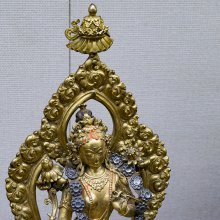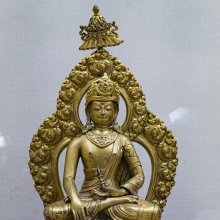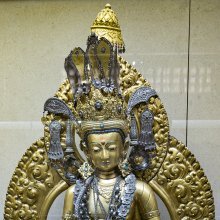Sim, Shim, Siṃ, Sīṃ: 9 definitions
Introduction:
Sim means something in Buddhism, Pali, Hinduism, Sanskrit, biology. If you want to know the exact meaning, history, etymology or English translation of this term then check out the descriptions on this page. Add your comment or reference to a book if you want to contribute to this summary article.
Images (photo gallery)
In Hinduism
Vyakarana (Sanskrit grammar)
Source: Wikisource: A dictionary of Sanskrit grammarSim (सिम्).—A technical term used in the Vajasaneyi-Pratisakhya for the first eight vowels of the alphabet, viz. अ, आ, इ, ई, उ, ऊ, ऋ (a, ā, i, ī, u, ū, ṛ) and ॠ; cf. सिमादितोष्टौ स्वराणाम् (simāditoṣṭau svarāṇām) V. Pr.. I.44.

Vyakarana (व्याकरण, vyākaraṇa) refers to Sanskrit grammar and represents one of the six additional sciences (vedanga) to be studied along with the Vedas. Vyakarana concerns itself with the rules of Sanskrit grammar and linguistic analysis in order to establish the correct context of words and sentences.
In Buddhism
Tibetan Buddhism (Vajrayana or tantric Buddhism)
Source: OSU Press: Cakrasamvara SamadhiSiṃ (सिं) is the bīja associated with Sindhu, according to Cakrasaṃvara-maṇḍala or Saṃvaramaṇḍala of Abhayākaragupta’s Niṣpannayogāvalī, p. 45 and n. 145; (Cf. Cakrasaṃvaratantra, Gray, David B., 2007).—The Cakrasaṃvara mandala has a total of sixty-two deities. [...] Three concentric circles going outward, the body, speech and mind wheels (kāya-vāka-citta), in the order: mind (blue), speech (red), and body (white), with eight Ḍākinīs each in non-dual union with their Ḍākas, "male consorts".
Associated elements of Mahābalā and Padmanṛtyeśvara:
Circle: kāyacakra (body-wheel) (white);
Ḍākinī (female consort): Padmanṛtyeśvara;
Ḍāka (male consort): Heruka;
Bīja: siṃ;
Body-part: soles;
Pīṭha: Sindhu;
Bodily constituent: aśrūni (tears);
Bodhipakṣa (wings of enlightenment): samyagdṛṣṭi (right view).

Tibetan Buddhism includes schools such as Nyingma, Kadampa, Kagyu and Gelug. Their primary canon of literature is divided in two broad categories: The Kangyur, which consists of Buddha’s words, and the Tengyur, which includes commentaries from various sources. Esotericism and tantra techniques (vajrayāna) are collected indepently.
Biology (plants and animals)
Source: Wisdom Library: Local Names of Plants and DrugsShim in the Hindi language is the name of a plant identified with Ranunculus sceleratus from the Ranunculaceae (Buttercup) family having the following synonyms: Ranunculus indicus, Ranunculus umbellatus. For the possible medicinal usage of shim, you can check this page for potential sources and references, although be aware that any some or none of the side-effects may not be mentioned here, wether they be harmful or beneficial to health.
Source: Google Books: CRC World Dictionary (Regional names)1) Sim in India is the name of a plant defined with Lablab purpureus in various botanical sources. This page contains potential references in Ayurveda, modern medicine, and other folk traditions or local practices It has the synonym Dolichos benghalensis Jacq. (among others).
2) Sim in Ivory Coast is also identified with Ficus exasperata It has the synonym Ficus exasperata Hort. Kew. ex Miq. (etc.).
3) Sim in Ivory Coast, Burkina Faso is also identified with Ficus sycomorus It has the synonym Ficus serrata Forssk. (etc.).
4) Sim in Vietnam is also identified with Rhodomyrtus tomentosa It has the synonym Myrtus tomentosus Glaz. (etc.).
Example references for further research on medicinal uses or toxicity (see latin names for full list):
· Flora Cochinchinensis (1790)
· Flore de Madagascar et des Comores (1952)
· Species Plantarum
· Vorlesungen der Churpfälzischen physicalisch-öconomischen Gesellschaft (1787)
· Species Plantarum (1753)
· Journal of Ethnopharmacology (2009)
If you are looking for specific details regarding Sim, for example health benefits, pregnancy safety, diet and recipes, chemical composition, side effects, extract dosage, have a look at these references.

This sections includes definitions from the five kingdoms of living things: Animals, Plants, Fungi, Protists and Monera. It will include both the official binomial nomenclature (scientific names usually in Latin) as well as regional spellings and variants.
Languages of India and abroad
Sanskrit dictionary
Source: Cologne Digital Sanskrit Dictionaries: Shabda-Sagara Sanskrit-English DictionaryṢim (षिम्).—[(u)ṣimu] r. 1st cl. (semati) To hurt or kill.
Source: Cologne Digital Sanskrit Dictionaries: Cappeller Sanskrit-English DictionaryŚim (शिम्).—śimyati = 1 śam.
--- OR ---
Sīm (सीम्).—([enclitic]) lays stress upon a [preceding] pronoun or preposition.
Source: Cologne Digital Sanskrit Dictionaries: Monier-Williams Sanskrit-English Dictionary1) Śim (शिम्):—(= √1. śam) [class] 4. [Parasmaipada] śimyati, to cut up, prepare (a sacrificial victim), [Taittirīya-saṃhitā; Kāṭhaka]
2) Sim (सिम्):—1. sim ind. [gana] cādi.
3) 2. sim (in Vedic gram.) a technical term for the eight simple vowels (viz. a, ā, i, ī, u, ū, ṛ, ṝ).
4) Sīm (सीम्):—ind. (originally [accusative] of a [pronoun] base and connected with sa as kīm with ka) him, her, it, them (employed for all genders, numbers and persons cf. id; īm, and [Greek] μιν, νιν; and often weakened into a generalizing and emphasizing particle, which may become an enclitic particle after a pronoun or preposition, = περ or cunque, often translatable by ‘ever’), [Ṛg-veda]
[Sanskrit to German]
Sanskrit, also spelled संस्कृतम् (saṃskṛtam), is an ancient language of India commonly seen as the grandmother of the Indo-European language family (even English!). Closely allied with Prakrit and Pali, Sanskrit is more exhaustive in both grammar and terms and has the most extensive collection of literature in the world, greatly surpassing its sister-languages Greek and Latin.
Nepali dictionary
Source: unoes: Nepali-English DictionarySīṃ (सीं):—[=सीँ] n. 1. sound produced while blowing one's nose; sniffle; snuffle; 2. (baby talk) mucus from nose;
Nepali is the primary language of the Nepalese people counting almost 20 million native speakers. The country of Nepal is situated in the Himalaya mountain range to the north of India.
See also (Relevant definitions)
Starts with (+18): Cimati, Shimadhada, Shimadhadya, Shimaga, Sim-antargata-vastu-sahita, Sima, Sima-ippacettu, Sima-kattirikkai, Sima-samuhana, Simaa, Simabandha, Simadharasvamin, Simadhipa, Simagiri, Simahidi, Simajnana, Simakata, Simakrishana, Simalinga, Simanishcaya.
Query error!
Full-text (+390): Maghashim, Caluh-sim-avacchinna, Sva-sim-avacchinna, Sim-antargata-vastu-sahita, Aththaya-Aimshi-Yashi-Yashim-Shim, Prasiddha-catuh-sim-avacchinna, Sapthei, Asimsati, Paccasimsati, Hong sim, Sim sa pap, Sim jangha, Sim el dabib, Sim-es-samak, Shagar-el-sim, Makhan-shim, Sims's azalea, Shimi, Apasaapasa, Masham.
Relevant text
Search found 47 books and stories containing Sim, Shim, Śim, Ṣim, Siṃ, Sīm, Sīṃ; (plurals include: Sims, Shims, Śims, Ṣims, Siṃs, Sīms, Sīṃs). You can also click to the full overview containing English textual excerpts. Below are direct links for the most relevant articles:
Rig Veda (translation and commentary) (by H. H. Wilson)
Khadira-grihya-sutra (by Hermann Oldenberg)
World Journal of Pharmaceutical Research
Updated review on lc-nmr < [2019: Volume 8, February issue 2]
Overview of methods for simvastatin and ezetimibe analysis. < [2021: Volume 10, September issue 11]
Hepatoprotective effects of Ocimum canum against isoniazid toxicity. < [2017: Volume 6, August special issue 9]
Shat-cakra-nirupana (the six bodily centres) (by Arthur Avalon)
Verse 41 < [Section 7]
The civilization of Babylonia and Assyria (by Morris Jastrow)
Preliminary phytochemical screening of some Indian Medicinal Plants < [Volume 29 (issue 2), Oct-Dec 2009]
Anti-acne activity of Darchini and Tukhm Khashkhash < [Volume 34 (issue 2), Oct-Dec 2014]
Less known edible fruit – yielding plants of nilgiris < [Volume 12 (issue 3-4), Jan-Jun 1993]


